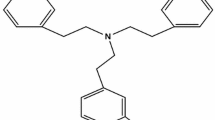Abstract
A series of alkyl phenol polyoxyethylene glycidyl ether (NP-n-O) and alkyl phenol polyoxyethylene ether hydroxypropyl sulfonate (NP-n-S) surfactants was synthesized to explore emulsification viscosity reduction. The optimum sulfonation conditions were obtained through orthogonal experiments, the ratio of alkyl phenol polyoxyethylene glycidyl ether and sodium bisulfite 1:1.5, 100 °C, and 6 h. The effects of concentrations of the synthesized surfactants, pH values, emulsifying temperature (40 and 60 °C) and water content on emulsification viscosity reduction and the stability of the emulsion to Venezuela’s Orinoco heavy oil were investigated. The water diversion ratio of emulsion at the reservoir temperature (55 °C) in 30 days was taken as an index, the results show that under the conditions of a temperature of 40 °C, an oil/water ratio of 7:3 and a surfactant NP-4-S concentration of 0.5 %, emulsions can be formed with a viscosity reduction rate reaching up to 99.69 % and with a water diversion ratio in 30 days reaching 9.38 %; while at 60 °C and an oil/water ratio of 7:3, at an NP-4-S concentration of 1 %, the viscosity reduction rate can reach 99.55 % and water diversion ratio is merely 4.23 % in 30 days. The mixture of NP-n-S, xanthan gum and cocamidopropyl dimethylamine oxide (CAO-30) at suitable concentration can greatly improve the emulsification viscosity reduction and emulsion stability, which gives an emulsion viscosity rate of over 98 %. Moreover, the emulsion can be stable for at least 30 days without water emerging.






Similar content being viewed by others
References
Alomair OA, Almusallam AS (2013) Heavy crude oil viscosity reduction and the impact of asphaltene precipitation. Energy Fuels 27:7267–7276. doi:10.1021/ef4015636
Fingas M, Fieldhouse B (2003) Studies of the formation process of water-in-oil emulsions. Mar Pollut Bull 47:369–396. doi:10.1016/S0025-326X(03)00212-1
Hasan SW, Ghannam MT, Esmail N (2010) Heavy crude oil viscosity reduction and rheology for pipeline transportation. Fuel 89:1095–1100. doi:10.1016/j.fuel.2009.12.021
Yaghi BM, Al-Bemani A (2002) Heavy crude oil viscosity reduction for pipeline transportation. Energy Sources 24:93–102. doi:10.1080/00908310252774417
Dong MZ, Ma SZ, Liu Q (2009) Enhanced heavy oil recovery through interfacial instability: a study of chemical flooding for Brintnell heavy oil. Fuel 88:1049–1056. doi:10.1016/j.fuel.2008.11.014
Zaki NN (1997) Surfactant stabilized crude oil-in-water emulsions for pipeline transportation of viscous crude oils. Colloids Surf A 125:19–25. doi:10.1016/S0927-7757(96)03768-5
Fan Y, Simon S, Sjöblom J (2009) Chemical destabilization of crude oil emulsions: effect of nonionic surfactants as emulsion inhibitors. Energy Fuels 23:4575–4583. doi:10.1021/ef900355d
Tang HC (2010) Studies on emulsified viscosity-reducing technique of heavy crude oil. China University of Petroleum
Qin, B (2001) Study on the relationship between the composition and performance of viscosity-reducing agent used in the viscous crude recovery. Research Institute of Petroleum Processing A Dissertation
Qin B, Luo YT, Li BG (2013) One type of emulsification viscosity reducing agent of crude oil. CN102876310
Xu B (2011) Research of heavy crude oil emulsification viscosity reducing system. Southwest Petroleum University
Wu XA, Czarnecki J (2005) Modeling diluted bitumen—water interfacial compositions using a thermodynamic approach†. Energy Fuels 19:1353–1359. doi:10.1021/ef040079j
Zaki Nael, Butz Thorsten, Kessel Dagobert (2001) Rheology, particle size distribution, and asphaltene deposition of viscous asphaltic crude oil-in-water emulsions for pipeline transportation. Pet Sci Technol 19:425–435. doi:10.1081/LFT-100000774
Wu BF (2011) Study on pour depression of Henan crude oil with high pour point and viscosity reduction of henan extra-heavy oil. South China University of Technology
Less Simone, Hannisdal Andreas, Sjöblom Johan (2008) An electrorheological study on the behavior of water-in-crude oil emulsions under influence of a DC electric field and different flow conditions. J Dispersion Sci Technol 29:106–114. doi:10.1080/01932690701688623
Mendoza A, Oliveros DA, Arellano D, Perozo H, Rinoza J, Rivas A (2011) New approach to upgrade the combustion in situ process by using an emulsified additive on heavy oil from Orinoco Belt. SPE enhanced oil recovery conference 1519-1527. ISBN 978-1-61839-092-9
Sullivan AP, Kilpatrick PK (2002) The effects of inorganic solid particles on water and crude oil emulsion stability. Ind Eng Chem Res 41:3389–3404. doi:10.1021/ie010927n
Wu YB, Jiang YW (2014) one type of heavy crude oil mining method by artificial bubble oil displacement. CN104213870 A
ISO 3001-1999 (1999) Plastics-Epoxy compounds-Determination of epoxy equivalent, 4th edn. ISO
Surface active agents; detergents; determination of anionic-active matter by manual or mechanical direct two-phase titration procedure. ISO-2271
Cui YC (2012) Synthesis and properties of amphoteric surfactants with ethylene oxide groups. Dalian University of Technology
Shi ML, Zhang GY, Lu SF (1993) Synthesis and Surface Active Properties of Sodium-3-Alkoxy-and 3-[Alkylmono (di) (oxyethylene) oxy]-2-hydroxy-1-propanesulfonates. Journal of Japan Oil Chemists Society 42: 52-54. ISSN 0513-398X
Shigemoto N, Al-Maamari RS, Jibril BY, Hirayama A, Sueyoshi M (2007) Effect of water content and surfactant type on viscosity and stability of emulsified heavy Mukhaizna crude oil. Energy Fuels 21:1014–1018. doi:10.1021/ef060259o
Arriola-Medellín AM, Salinas-Bravo VM (2015) Rheology and stability of emulsions of oil refining residuals in water. Pet Sci Technol 33:460–466. doi:10.1080/10916466.2014.994711
Kowalska M, Zbikowska A, Marciniak-Lukasiak K, Smiechowski K (2015) Stability and the distribution of droplets in walnut oil water-based emulsions formed at different pH. J Dispersion Sci Technol 36:740–746. doi:10.1080/01932691.2014.919586
Dehghan AA, Masihi M, Ayatollahi S (2013) Evaluation of chemicals interaction with heavy crude oil through water/oil emulsion and interfacial tension study. Energy Fuels 27:5852–5860. doi:10.1021/ef401361t
Fan Y, Simon S, Sjöblom J (2009) Chemical destabilization of crude oil emulsions: effect of nonionic surfactants as emulsion inhibitors. Energy Fuels 23:4575–4583. doi:10.1021/ef900355d
Acknowledgments
The authors appreciate finical support from the CNPC Research Institute of Science and Technology (RIPED.CN-2015-JS-11).
Author information
Authors and Affiliations
Corresponding author
About this article
Cite this article
Bao, L., Wang, H., Wu, Y. et al. Synthesis of a Series of Anionic Surfactants Derived from NP and their Properties as Emulsifiers for Reducing Viscosity of Highly Viscous Oil via Formation of O/W Emulsions. J Surfact Deterg 19, 979–987 (2016). https://doi.org/10.1007/s11743-016-1843-6
Received:
Accepted:
Published:
Issue Date:
DOI: https://doi.org/10.1007/s11743-016-1843-6




